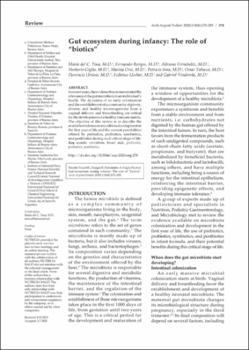| dc.contributor.author | Burgos, Fernando. | |
| dc.contributor.author | Toca, María. | |
| dc.contributor.author | Fernández, Adriana. | |
| dc.contributor.author | Et al. | |
| dc.date.accessioned | 2024-02-05T14:44:23Z | |
| dc.date.available | 2024-02-05T14:44:23Z | |
| dc.date.issued | 2020-08 | |
| dc.identifier.citation | Arch Argent Pediatr . 2020 Aug;118(4):278-285 | es |
| dc.identifier.issn | 1668-3501 | |
| dc.identifier.uri | https://riu.austral.edu.ar/handle/123456789/2700 | |
| dc.description | Disponible en: https://www.sap.org.ar/docs/publicaciones/archivosarg/2020/v118n4a14e.pdf | es |
| dc.description.abstract | Abstract in English, Spanish
In recent years, the evidence has demonstrated the relevance of the gut microbiota in an individual's health. The dynamics of an early colonization and the establishment of a community of plenty, diverse, and healthy microorganisms from a vaginal delivery and breastfeeding are critical for the development of a healthy immune matrix. The objective of this review is to describe the available evidence on microbiota development in the first year of life and the current possibilities offered by prebiotics, probiotics, symbiotics, and postbiotics during such critical stage of life.
Keywords: breast milk; microbiota; postbiotics; prebiotics; probiotics.
Sociedad Argentina de Pediatría.
PubMed Disclaimer | es |
| dc.language.iso | en | es |
| dc.publisher | Archivos Argentinos de Pediatría | es |
| dc.rights | Attribution-NonCommercial-NoDerivatives 4.0 Internacional | * |
| dc.rights.uri | http://creativecommons.org/licenses/by-nc-nd/4.0/ | * |
| dc.subject | Breast milk | es |
| dc.subject | Microbiota | es |
| dc.subject | Postbiotics | es |
| dc.title | Gut ecosystem during infancy: The role of "biotics" | es |
| dc.type | Article | es |


